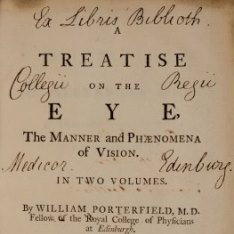
Biography
William Porterfield, President of the Royal College of Physicians of Edinburgh between 1748 and 1750, has variously been called the ‘father of ophthalmology’, Edinburgh’s first professor of physiology and the first to describe and name phantom limb. As we shall see, none of these claims are strictly accurate.
Porterfield was born in Ayrshire in 1696 and is said to have studied medicine in Glasgow before going to Rheims and Leiden. In fact, Glasgow did not have a faculty of medicine at that time and Porterfield is far more likely to have studied mathematics, for which Glasgow was famous. Most of his time would have been spent in Leiden before he graduated MD in Rheims (1717), a combination of universities used by many Scots students of the time.
In June 1721 Porterfield was formally examined and admitted as a Licentiate of the Edinburgh College and elected to its Fellowship later in the year. Within a few years he was himself one of the College examiners and in 1724 a professor.
Why or when he developed his interest in optics is not known. His name was made with A treatise on the eye: the manner and phenomena of vision (1759), described by one ophthalmic historian in 1936 as ‘a remarkable and extraordinarily able work, far ahead of any other of similar scope then available in English. In it are theorems amply elucidating the problems of optics, many of which are held as good today, and thus give evidence of the thoroughness of the author’s powers of observation.’
The books were based on two articles Porterfield had written many years before and published in the Edinburgh Medical Essays and Observations. The first (1737) was about what he termed the external motions of the eye; the second (1738) was about the internal motions. This pioneering work on the physiology of the eye led some to refer to him as the father of ophthalmology. However, there is no evidence that Porterfield ever practised clinical ophthalmology or studied its pathology.
Neither was he strictly a professor of physiology, for there was no such department in the Edinburgh of his day. In 1723, at the invitation of the town council, the President and censors of the Edinburgh College unanimously agreed that his name should be submitted to be professor, teaching physiology, materia medica and physic as well as the practice of medicine. The nomination was applauded by 15 Fellows at a subsequent meeting. Quoting from Council minutes, ‘they granted him all powers, privileges and immunities enjoyed by any other professor but at the same time no salary.’
In 1685 Archibald Pitcairne, Robert Sibbald and James Halkett, all founding Fellows of the College, had been appointed to teach medicine in the university. Not only had they too no salary, no rooms and almost no students, they never gave a single lecture or tutorial. If the Council was hoping that Porterfield would succeed where the others had failed, they were mistaken. He too never taught anyone, although, as one writer has said, ‘he seemed disengaged from the necessary business of all other public professions.’ (Porterfield is known to have been so wealthy that he needed no financial incentives.) There is no record of him tendering his resignation, but two successors were appointed a year and a half after Porterfield took up his post.
Porterfield was well qualified to write about ‘phantom limb’, having had a leg amputated in his youth. However, he did not coin the phrase; that was done by George Dedlow in 1872. Porterfield’s claim to fame in this respect rests on him being the first doctor to describe it from personal experience:
‘All things perceived must therefore be present with the Mind and in the Sensorium where the Mind resides… the Sense of Feeling is diffused thro’ all the body. Nay, in some cases it behived to be extended beyond the Body itself as in the case of Amputations… Having had this Misfortune myself, I can the better vouch for the Truth of this fact from my own Experience, for I sometimes still feel Pains and Itchings, as if in my tows, Heel or Ancle and tho’ it be several years since my leg was taken off.’
Before then most papers had relied on second- or third-hand reports. Not surprisingly, Porterfield saw similarities between the visual sensation and that experienced after amputation. He graphically described the sensations of pain and itching, but for some reason did not refer to the papers and reports of others, including Déscartes who so eloquently described the suffering of a girl after a limb amputation.
Porterfield was a man who attracted unfavourable, even scathing, criticism, but that was common at the time. Apart from the fact that Porterfield married a Mrs Elizabeth Brown, widow of David Henderson of Tunnochside, in March 1743, we know little else about his private life.
Notable Achievements
Porterfield was president of the Royal College of Physicians of Edinburgh from 1748 to 1750.
Key Publications
- A treatise on the eye: the manner and phenomena of vision (1759)
Previously published in the Journal of the Royal College of Physicians of Edinburgh (2010), 40: 188
Author: Derek Doyle.



